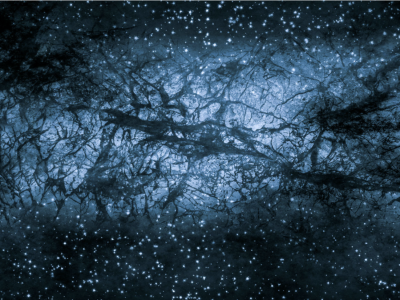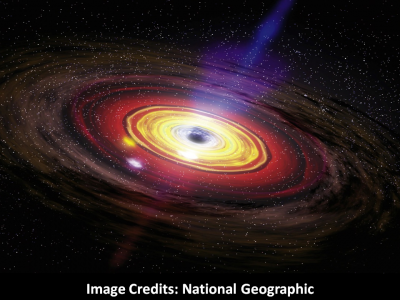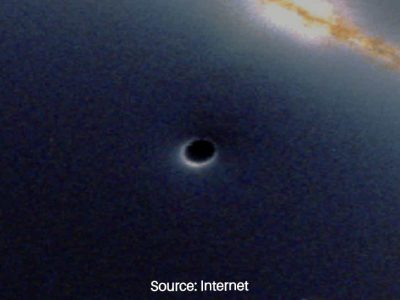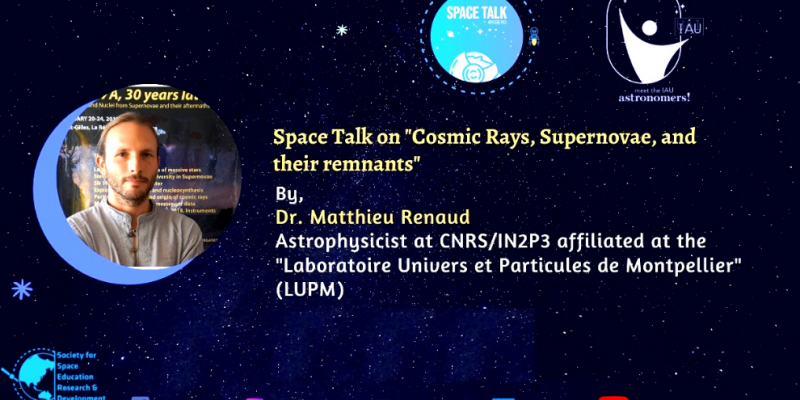
Stars and all the phenomena related to them have been a center of interest for astrophysicists for a long time. They have been studying the life and death of a star, and in this journey, they discovered the brightest explosion humans have ever observed – called Supernovae.

A Supernova (Image Credit: cdn.mos.cms.futurecdn.net)
Various questions such as, ‘What exactly is a supernova?’, ‘How are they formed?’, ‘Will Sun become supernova?‘ are revolving in the minds of space enthusiasts.
The supernova remnants, left behind after the supernova, are also a ‘center of research’ for astrophysicists. The reason behind this is the fact that for a long time, and even now, scientists believe that these remnants are the core source of some high-energy particles – called Cosmic Rays.

Cosmic Rays (Image Credit: Medium)
This fascinating shower of particles was first observed by an Australian physicist Victor Hess in 1912 with his historic balloon flight. In the flight, what he did was, when the balloon was ascended to 5300 meters, he measured the ratio of ionization in the atmosphere. In this process, he found that the ionization rate has been increased to three times at sea level, and hence, discovered the Cosmic Rays.

Victor Hess Balloon Flight in 1912 (Image Credit: Research Gate)
What are Cosmic Rays?
Cosmic Rays are nothing but high-energy particles, originated from some astronomical processes, traveling at nearly the speed of light (3E+08 m/s).
In outer space, these cosmic rays are composed of 89% of protons (nuclei of Hydrogen), 10% nuclei of Helium, and 1% of all other nuclei up to Uranium, and when arriving at Earth, the studies revealed that these collides with the atmospheric nuclei – creating Pions.
These pions are the secondary particles formed while reaching the Earth’s atmosphere, more massive than electrons but lesser than protons and neutrons. In the atmosphere, the charged pions are further decayed – emitting another particle called muons.
These muons are not much interactive with the surrounding matter, thus penetrates the ground. While the neutral pions, as they’re neutral, decay themselves into gamma rays with a characteristic energy of about 67MeV.
In the blog published by CERN, the fact was mentioned that the study of Cosmic Rays opened the doors for the discovery of particles such as the first antimatter, the positron (antimatter of electron) in 1932, the Muon (followed by the Pion) in 1937, the Kaon, and several others.

Pions (Image Credit: Wikipedia)
But, what are the source(s) of the Cosmic Rays? From where are they formed? And, how will they be useful for us in scientific research? – Read on to find the answer!
The core source of the Cosmic Rays
This question has been a topic of debate for scientists for decades. For the low-energy particles, they know it is the solar wind, but for the high-energy particles, finding the core source becomes difficult due to the twisting and turning magnetic field.
Then, how they identified the source of cosmic rays? – By studying high-energy gamma rays of outer space. Here, you probably have a question in your mind – How are gamma rays helping to study cosmic rays? Or How are they related?
Though they are lesser in amount than the charged cosmic rays, they still help in providing the evidence, as they are neutral and not influenced by the interstellar magnetic field. As earlier mentioned, gamma rays produce secondary particles called pions, which can be detected from Earth.
When NASA took the gamma-ray observations with respect to the galactic plane (the plane where the majority of the mass lies in a disk-shaped galaxy), they observed an increase in the flux around 67MeV, which is the characteristic energy of gamma-rays when neutral pions decay – thus, indicate that these cosmic rays are interactive to the interstellar material (i.e., magnetic field) through Milky Way.
NASA’s GLAST’s Large Area Telescope (LAT) data collection for few years, which gave them a clue that supernovae may be the possible source for the cosmic rays. And for decades, they had been pointing out the likely source to be supernovae remnants.
Scientists believe that the natural accelerators that influence this shower of particles are the shock waves from the stellar explosion, indirectly the supernovae remnants. – Now, you might be thinking about how these shock waves are produced and what is their role in cosmic rays?
Basically, what happens here is, whenever a massive star explodes to become a supernova, gaseous structures are formed via some blast waves (called shock waves), which interact with the interstellar magnetic fields and generally form in supernova remnants. These shock waves have enough energy to accelerate protons and other particles. Thus, producing cosmic rays.
On Feb 14, 2013 – NASA’s Fermi Gamma-Ray Space Telescope gave the first strong evidence that “they are explosions of massive stars that produce some of the fasting-moving matter in the universe.” – A major step towards knowing the origin of cosmic rays.

The Fermi Gamma-ray Space Telescope (Image Credit: NASA)
“Now we have conclusive proof supernova remnants, long the prime suspects, really do accelerate cosmic rays to incredible speeds.” – Elizabeth Hays (research team member and Fermi deputy project scientist)
With the four years of data analysis since its launch in 2008 concerning two particular supernovae remnants IC 443 and W44, Fermi scientists were able to identify a distinguishable feature in both remnants, indicating that the feature is due to the neutral pion, which decays into two gamma rays. Gamma rays are the proof that protons are emitted in abundance from the interstellar gas clouds, and these clouds are due to the supernova remnants.
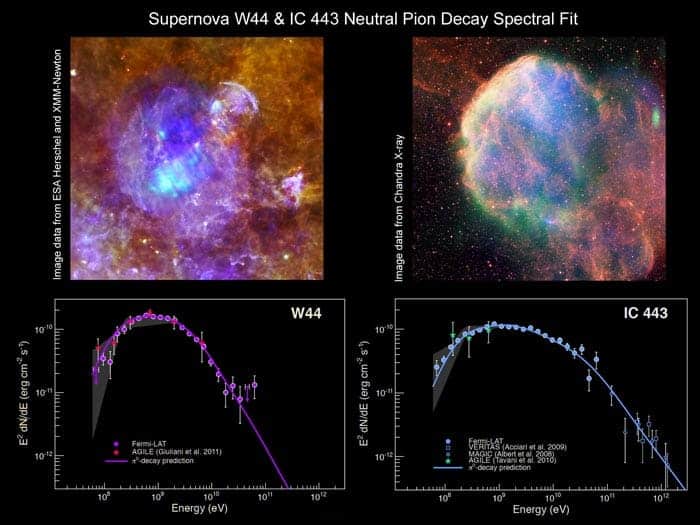
Supernovae IC 443 and W44 Neutral Pion Decay Spectral Fit (Image Credit: Physics World)
We’ve been talking about the supernovae remnants as the core source of cosmic rays. But do you know much about them? How are they formed? and what’s the need for studying them? – So, let me give you a brief outline of supernovae and their remnants.
Supernovae and their remnants: A brief introduction
This explosive phenomenon, which is considered the brightest and biggest explosion humans have ever witnessed, starts from the death of a massive star.
When a massive star runs out of fuel, they become red supergiants and try to keep themselves alive up to a few million years. After that, they blow apart themselves, and this explosion is called a supernova. But, not every star explodes into a supernova. Instead, it depends on the mass of the star.
A question that arises here is, “Will the Sun becomes a supernova?” – NO, the Sun won’t become a supernova because of its smaller size and lesser mass than the other stars. If not a supernova, then what would be the fate of the Sun? – Possibly in a couple of billion years, the Sun will also run out of fuel and become a red dwarf followed by cooling itself down to a white dwarf.
To be exploded as a supernova, a star should be at least eight times massive than the Sun. There are two ways by which a star becomes a supernova:
- Type I Supernova: A star accumulates surrounding matter in it until the ignition of a nuclear reaction. After the reaction, the star explodes itself into a supernova.
- Type II Supernova: Whenever a star runs out of fuel, it is collapsed in its intrinsic gravity.
Whenever a star becomes a supernova, it left behind a nebula, which is nothing but the supernova remnant. To understand the galactic structure, the study of remnants is essential.
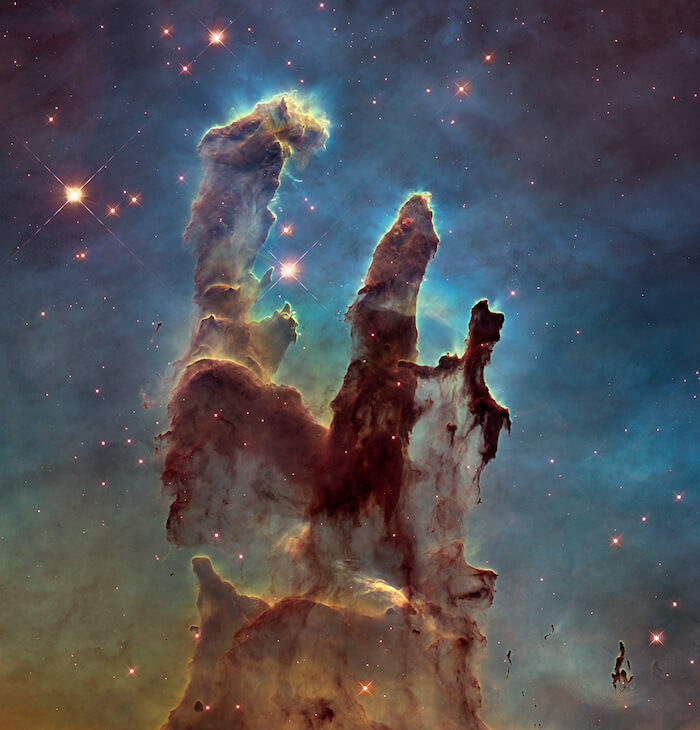
A Nebula (Image Credit: spaceplace.nasa.gov)
They are the ones who are responsible for the heating of interstellar gas via magnetic turbulence and shock waves they produce, and they are the core source of the heavy elements and cosmic rays (which we have covered in the above discussion).
For detailed information on supernovae, read our previous article: “Supernova: the Brightest explosion in space“ and watch SSERD’s Space Talk by Dr. Matthieu Renaud on “Cosmic Rays, Supernova and their remnants” on youtube.
Author
